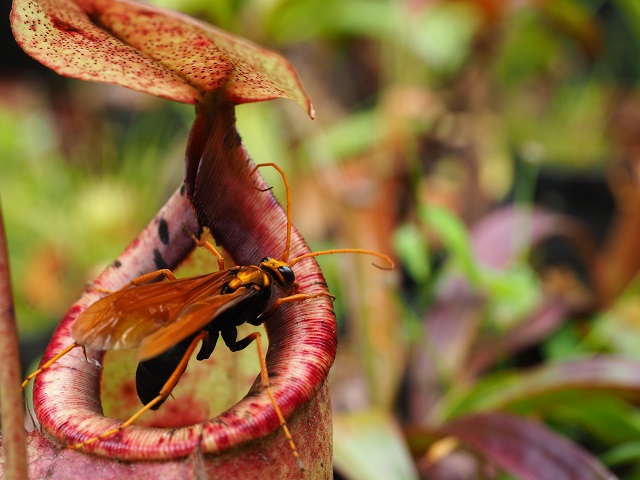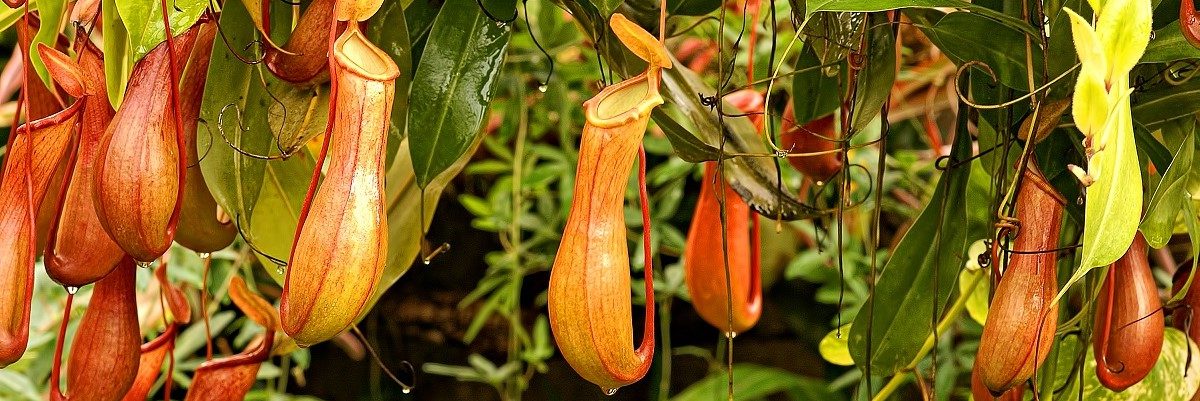Pitcher plants are carnivorous plants with pitcher-shaped leaves that form a pitfall trap. Insects and other small prey are attracted to the sweet-smelling nectar on the lip of the pitcher’s opening. The prey slips on the lip and into the liquid-filled belly of the plant, which has smooth walls to prevent escape. The liquid inside the plant then slowly digests the prey.
The rest of this article will tell you all you need to know about pitcher plants: their diet, environment, anatomy, and even whether it’s safe to drink from one.
How Would You Describe a Pitcher Plant?
As its name suggests, the pitcher plant is elliptical in shape with a wide opening into a deep, liquid-filled cavity. A large extruding leaf, which grows from the back of the pit, sits high above the cavity in order to keep out rainwater.
The color of pitcher plants depends upon the species. While they can range from yellow-green to fully green or dark red, the most common color combination is green with dark red or purple veins.
The wide lip of the pitcher plant is shiny and secretes nectar, effectively attracting prey to the slippery ledge, where they fall into the smooth-walled vessel.
Why is it Called a Pitcher Plant?
The shape of its specialized leaves, which are formed to mimic a pitcher, is what lends this unique carnivorous plant its name. Their appearance has also been compared to trumpets, jugs, or urns. They also store small amounts of rainwater, which may also contribute to this perception.
However, no matter what you call it, all pitcher plant varieties have the same basic shape: an oblong vessel filled with digestive fluid, which most botanists refer to as a pitfall trap.
Are There Different Kinds of Pitcher Plants?
| Nepenthaceae – previously known as the Old World pitcher plants, these are also called tropical pitcher plants or “monkey cups,” according to Britannica.com. Nepenthes are the most diverse class of pitcher plants and include roughly 140 species. They are native to Madagascar, Southeast Asia, and Australia. |
| Sarraceniaceae – commonly referred to as New World varieties of pitcher plant, 34 species in this family are all native to North and South America. |
| Cephalotaceae – also known as the Western Australian pitcher plant, is the only species of pitcher plant in the flowering plant variety, Cephalotaceae. It differs from the New and Old World species of pitcher plant by sporting traditional leaves in addition to its pitfall traps and has long flowering stalks far from its traps so as to protect pollinators. |
Why Are Pitcher Plants Carnivorous?
Pitcher plants are native to environments with poor soil, necessitating supplementing their diet with insects and other prey.
Pitcher plants from the family Sarraceniaceae, those native to North and South America, are primarily found in swamps, bogs, and sandy marshes. The soil is acidic, watery, and devoid of nutrients. Adaptation to this nutrient-poor soil is evident in pitcher plants’ shallow rhizomes, which – instead of a sprawling root system – store nutrients to keep the plant alive when prey is sparse.
Pitcher plants rely on insects and other prey to obtain nutrients such as nitrogen and phosphorous since the environments in which they thrive are lacking.
Unlike other species of carnivorous plants (such as the Venus flytrap and Drosera), pitcher plants employ a more passive way of catching prey. The Venus flytrap and Drosera (also known as sundews) ensnare their prey through trichomes triggered when prey land on them, prompting the plant to close or roll up, effectively trapping their prey.
However, pitcher plants don’t have trichomes that prey trigger. Their pit remains open, and prey drowns in the liquid while digestive juices at the bottom slowly break them down.
What’s Inside a Pitcher Plant?
Below the waxy, nectar-rich rim of the pitcher plant, a wide, elliptical vessel filled with digestive enzymes forms the pitfall trap for which the pitcher plant is so well known. The walls are smooth, and some species sport stiff, downward-slanted hairs that make it impossible for prey to climb back out.
The liquid inside the pitcher plant is a simple mixture of rainwater and digestive enzymes.

Can Anything Live Inside a Pitcher Plant?
While most insects and other small prey (small frogs, spiders, etc.) that enter a pitcher plant usually end up being the meal, some species depend on the pitcher plant for a variety of reasons:
| Tree shrews – 3 species of Nepenthes engage in mutualism with the mountain tree shrew of Borneo. Attracted by the rich, sweet nectar on the pitcher plant’s rim, the tree shrew collects the nectar and places its rear end over the pit, dropping feces into the pitfall trap. Tree shrew feces are a valuable source of nitrogen for the pitcher plant. |
| Mosquitos – according to Sarracenia.com, some mosquito species lay their eggs inside the deep vessel of the pitcher plant, and the larvae aren’t affected by the digestive enzymes. The mosquito larvae are parasitic on the plant, robbing it of nutrients. |
| Spiders – there have been reports of certain species of spiders stealing prey from inside pitcher plants. |
| Ants – one species of pitcher plant, Nepenthes bicalcarata, has a mutualistic relationship with ants, which eliminates destructive mosquito larvae from the pitcher plant. The ants thrive off the nectar and larvae inside the liquid. |
Can You Drink from a Pitcher Plant?
Despite containing the plant’s digestive enzymes, the liquid inside a pitcher plant is safe for human consumption. The pH is a neutral 7.0; according to VenusFlyTrapWorld.com, it tastes like rainwater. This makes sense, as most of the liquid inside a pitcher plant is likely rainwater.
The liquid inside the pitcher plant is also safe for pets, so there is no risk of poisoning if your pet eats the pitcher plant.
Important note: depending on when the plant last digested prey, residue from the pitcher plant’s most recent meal may still be inside the liquid.
References
https://www.britannica.com/plant/pitcher-plant
https://www.ncbi.nlm.nih.gov/pmc/articles/PMC3115346/
https://www.sciencedaily.com/releases/2013/05/130522180304.htm


